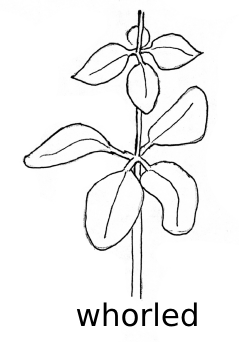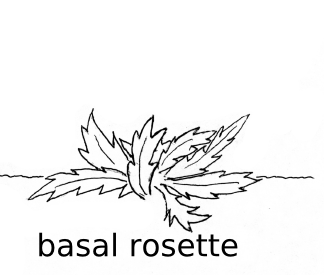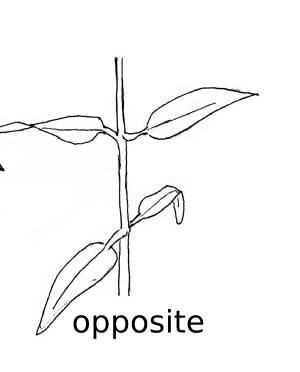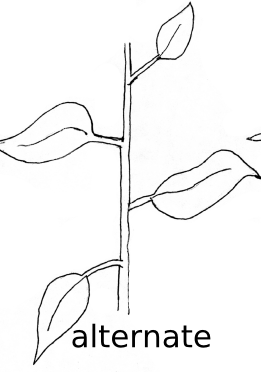
\[120^\circ \] Phyllotaxy occurs in?
Answer
510k+ views
Hint: Phyllotaxy is the pattern of arrangement of leaves on the stem or branch. The basic arrangements we see in leaves, stems, axis or branches from our naked eyes that is phyllotaxy. It is necessary as the leaf gets enough space to grow. There are different types of phyllotaxy which will be discussed here.
Complete answer:
Phyllotaxy is usually of three types. Alternate phyllotaxy, opposite phyllotaxy and whorled phyllotaxy. The basic arrangements of leaves on a stem are opposite and alternate which is also known as spiral.
In an alternate type of phyllotaxy, a single leaf arises at each node in an alternate manner. Example- china rose, mustard, and sunflower plants. In opposite types of leaves arise at each node and lie opposite to each other as in plants like Calotropis and guava plants.
In whorled phyllotaxy if more than two leaves arise at a node and form a whorl, it is called whorled as in plants like alstonia. The whorled arrangement is fairly unusual on plants except for those with particularly short internodes. A basal whorl with a large number of leaves spread out in a circle is called rosette.
Distichous phyllotaxy is also called two-ranked leaf arrangement is a special case of either opposite or alternate leaf arrangement where the leaves on a stem are arranged in two vertical columns on opposite sides.
Tristichous phyllotaxy is the mode of arrangement of three leaves in one spiral. It is called a three-ranked arrangement. The arrangement of first, fourth, seventh, and tenth leaf remains in row while the third, sixth, ninth and twelfth in second row and second, fifth, eighth and eleventh in the third row. So, the angular divergence is \[120^\circ \]. For example – Cyperus plant.
Note:
Plant shows arrangement of leaves to get proper sunlight, inflorescence of flower also grow better most plants show alternate phyllotaxy as it is most common phyllotaxy and the rarest one is whorled phyllotaxy. Opposite is also seen in many plants.




Complete answer:
Phyllotaxy is usually of three types. Alternate phyllotaxy, opposite phyllotaxy and whorled phyllotaxy. The basic arrangements of leaves on a stem are opposite and alternate which is also known as spiral.
In an alternate type of phyllotaxy, a single leaf arises at each node in an alternate manner. Example- china rose, mustard, and sunflower plants. In opposite types of leaves arise at each node and lie opposite to each other as in plants like Calotropis and guava plants.
In whorled phyllotaxy if more than two leaves arise at a node and form a whorl, it is called whorled as in plants like alstonia. The whorled arrangement is fairly unusual on plants except for those with particularly short internodes. A basal whorl with a large number of leaves spread out in a circle is called rosette.
Distichous phyllotaxy is also called two-ranked leaf arrangement is a special case of either opposite or alternate leaf arrangement where the leaves on a stem are arranged in two vertical columns on opposite sides.
Tristichous phyllotaxy is the mode of arrangement of three leaves in one spiral. It is called a three-ranked arrangement. The arrangement of first, fourth, seventh, and tenth leaf remains in row while the third, sixth, ninth and twelfth in second row and second, fifth, eighth and eleventh in the third row. So, the angular divergence is \[120^\circ \]. For example – Cyperus plant.
Note:
Plant shows arrangement of leaves to get proper sunlight, inflorescence of flower also grow better most plants show alternate phyllotaxy as it is most common phyllotaxy and the rarest one is whorled phyllotaxy. Opposite is also seen in many plants.




Recently Updated Pages
The number of solutions in x in 02pi for which sqrt class 12 maths CBSE

Write any two methods of preparation of phenol Give class 12 chemistry CBSE

Differentiate between action potential and resting class 12 biology CBSE

Two plane mirrors arranged at right angles to each class 12 physics CBSE

Which of the following molecules is are chiral A I class 12 chemistry CBSE

Name different types of neurons and give one function class 12 biology CBSE

Trending doubts
One Metric ton is equal to kg A 10000 B 1000 C 100 class 11 physics CBSE

What is 1s 2s 2p 3s 3p class 11 chemistry CBSE

Discuss the various forms of bacteria class 11 biology CBSE

State the laws of reflection of light

Explain zero factorial class 11 maths CBSE

An example of chemosynthetic bacteria is A E coli B class 11 biology CBSE




